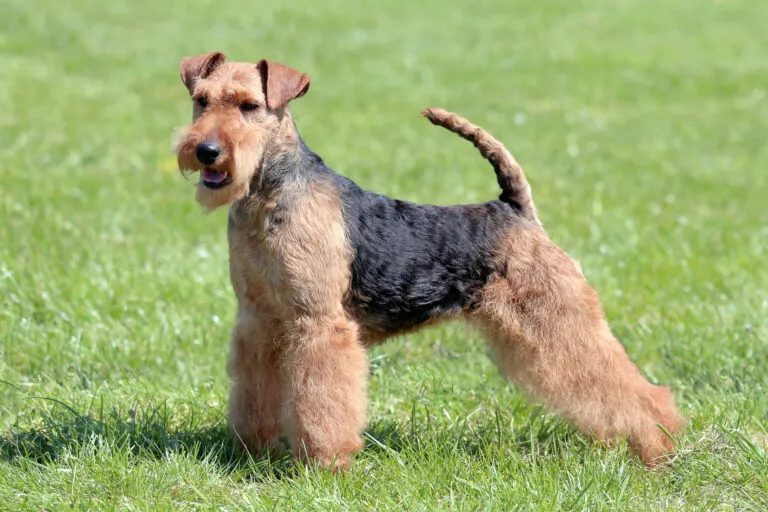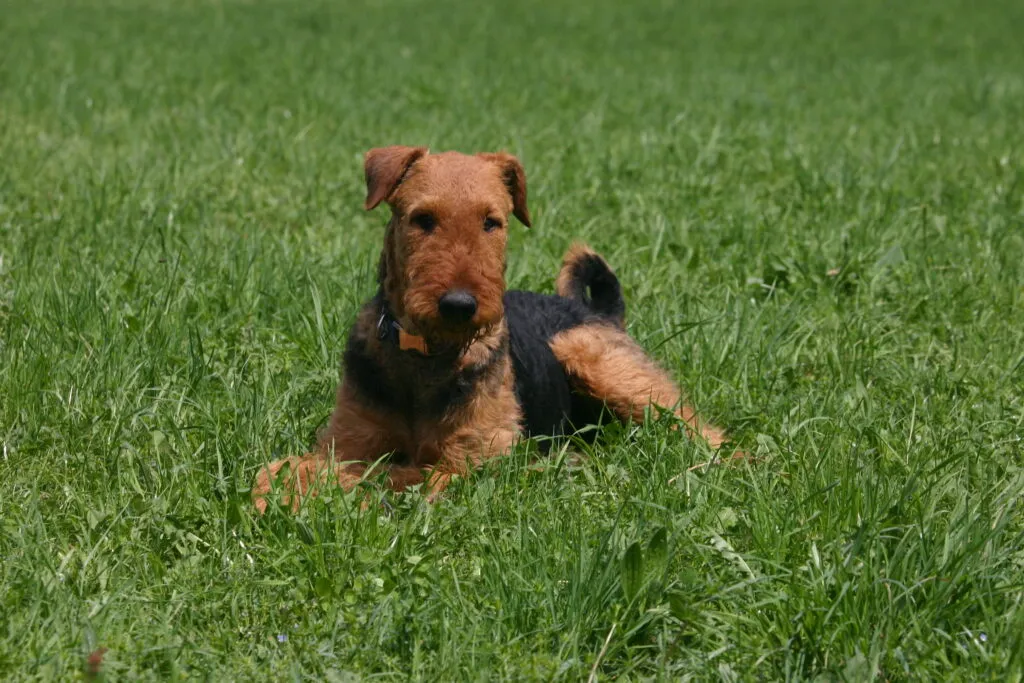Medium Size Poodle
Think of the Welsh Terrier as a miniature version of the Airedale Terrier, though the two breeds are not closely related. With a rich history as a fox-hunting dog, the Welsh Terrier is now a wonderful family pet known for its cheerful and lively temperament.

© Vincent / stock.adobe.com
A Welsh Terrier is a great fit for families – as long as he gets enough exercise
With a shoulder height of 36 to 39cm and a weight between 8 and 10kg, the Welsh Terrier is a medium-sized breed. Its compact body is well-proportioned, revealing agility and power.
Often nicknamed the “small Airedale Terrier” due to its similar appearance, the Welsh Terrier sports a black or dark-grey saddle (“grizzle” = mottled) on its otherwise tan fur. This breed is known for its coarse, wiry top coat and dense, soft undercoat, forming the so-called English jacket. This ensemble protects it effectively from wind, rain, and cold.
Its V-shaped ears are folded forward on a long, flat skull, and its high-set rod, which was historically docked, now usually remains in its natural, medium length. The small, dark, button-like eyes are distinctive and give the dog an alert, expectant expression.
Boredom is a foreign concept to the Welsh Terrier! This lively bundle of energy boasts a personality packed with a wide range of traits that keep its owners both entertained and active. This sport-loving, intelligent dog needs both physical and mental stimulation.
Dog sports like agility, obedience, disc dogging, or tournament dog sports are perfect for this agile Welshman.
The Welsh Terrier’s joyful, spirited nature is infectious, making it easy for the family to join their adventurous pet on outings. Properly trained and socialised, it proves to be an obedient dog that is neither shy nor nervous around strangers or other dogs. However, remember that its fox-hunting instincts can sometimes get the better of it on walks.
A consistent approach to training and early socialisation are crucial for this intrepid English breed. Its hunting instincts and occasionally dominant, moody nature call for clear boundaries, firm commands, and a reliable, calm leader. Beginner dog owners should consider attending puppy classes to ease into the training process.
With the right training foundation, the Welsh Terrier becomes less challenging. Though it can be headstrong, this friendly, affectionate breed longs for closeness and harmony. Unlike other terrier breeds, the Welsh Terrier is less prone to conflicts and is generally obedient.
 © Volker Maiborn / stock.adobe.co
© Volker Maiborn / stock.adobe.co
Owning a Welsh Terrier means getting creative with activities. A simple walk around the block won’t satisfy this energetic Brit. Your weekly schedule should include joint jogging runs, diverse walks, hikes, bike rides, and, of course, dog sports. A dog park where your pet can freely run is also a good option for those busy days when you can’t do the “full programme.”
Time is a crucial factor when considering a Welsh Terrier. To nurture this dog’s intelligence and physical fitness, you’ll need various ideas and activities. If you spend a lot of time in the office or travelling, this breed may not be a fit for you. A Welsh requires an active family that shares its zest for life and has enough time to dedicate to it.
Living in the countryside or the city doesn’t matter much. As long as the Welsh Terrier is physically and mentally stimulated, it adapts well to its environment. Despite its “terrier traits” like stubbornness and dominance, it is very easy-going at home. Thanks to its size, it can comfortably live in a small space, provided it’s near its owner. Besides plenty of exercise, a Welsh Terrier needs attention and affection.
The Welsh Terrier’s wiry top coat doesn’t need bathing or shampooing and should not be clipped. After a long walk in nature, just wipe the fur with a cloth or dog glove.
One advantage is that the Welsh Terrier hardly sheds. Regular brushing or combing removes dead hairs. To maintain its breed-typical appearance, the coat should also be trimmed professionally three to four times a year.
A healthy diet significantly contributes to your dog’s wellbeing and can prevent many diseases. It is vital that the food is nutritious and supplies all necessary nutrients in the correct amounts.
Dogs are naturally carnivores and require more meat than humans. However, meat alone isn’t enough. The food should generally consist of about 70 to 80% meat, 20 to 30% vegetables, and about 5 to 10% rice, grain or potatoes. Consult your vet for a detailed dietary analysis that takes into account your dog’s age, size, weight, activity, and health.
Read our article on dog food: wet vs dry?
Thanks to the careful breeding practices of dedicated Welsh Terrier enthusiasts, the breed has retained its original characteristics and hasn’t fallen prey to mass production or questionable trends. Through careful selection and genetic testing of breeding dogs, they’ve maintained the breed’s robust health.
Welsh Terriers live an average of 14 to 15 years with proper care and health management.
No particular breed-specific diseases are linked to Welsh Terriers, though glaucoma can occasionally be an issue. This condition, characterised by increased eye pressure, can damage the optic nerve and retina, leading to blindness if untreated. Early signs include red eyes, dilated pupils, eye rubbing, or frequent blinking. Immediate veterinary advice is essential for treatment.
If interested in a Welsh Terrier, arrange an initial meeting with a breeder. This isn’t about finalising a purchase but getting a thorough understanding of the breeder, their dogs, and their kennel.
A reputable breeder will willingly show you around (including the mother dog) and share a wealth of information about the breed and their specific dogs. They won’t rush you into buying a puppy. Instead, they’ll ask questions to evaluate if you’re a suitable owner. Even seasoned breeders find parting with puppies tough, so it’s important they feel confident their puppies are going to a good home.
From a reputable breeder, Welsh Terriers typically cost £1,500 or more.
Despite the resemblance to the Airedale Terrier, Welsh Terriers are not closely related. In fact, the Welsh Terrier is much older. Its ancestors, likely the Black and Tan Terriers, date back to the 10th century.
First documented in 1737, the breed was initially known as the Carnarvonshire Welsh Terrier.
Historical records show that Welsh Terriers were originally used for badger, otter, and fox hunting. The Welsh valued their agility and skill in driving foxes out to the hunters. For centuries, this was their primary role, and the breed remained relatively unknown outside Wales.
This changed in the late 19th century when Welsh breeders standardised the breed through selective breeding.
The first Welsh Terrier Club was established in England in 1886, along with the official breed standard. This standard remains largely unchanged and forms the basis for the Fédération Cynologique Internationale (FCI) standard, where the Welsh Terrier is classified under number 78 in Group 3 (Terriers) and Section 1 (Long-legged Terriers).
Since 1895, the Welsh Terrier has been shown in dog exhibitions worldwide, remaining most prevalent in its native Britain. It’s a beloved companion among hunters and families alike.
Fans of the Bearded Collie agree that those who aren't familiar with this dog breed simply have to get acquainted with it. And those who have experienced how a Bearded Collie bolts across meadows with its flowing fur, how it rolls around full of energy and joy and how it attentively and observantly takes into account its owners wishes become simply addicted to this original dog breed and its unique charm.
The Goldendoodle isn't a breed, but a pairing between Golden Retrievers and Medium or Standard Poodles. Marketed as a low-maintenance dog for allergy sufferers, this hybrid is enjoying increasing popularity amongst dog lovers, similar to the Labradoodle.